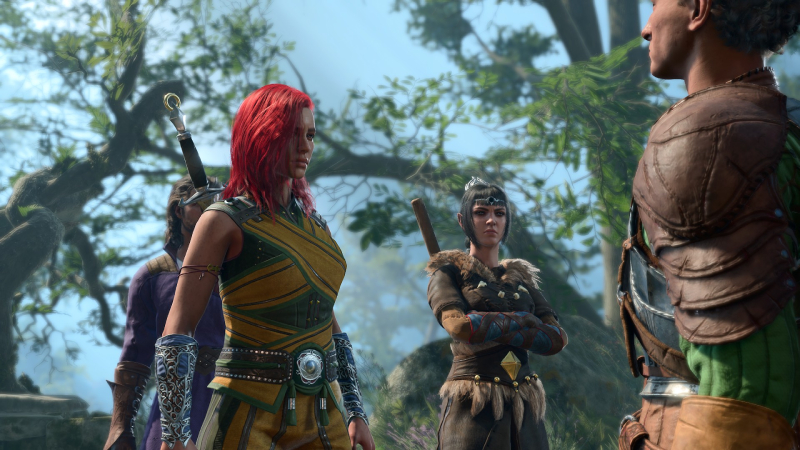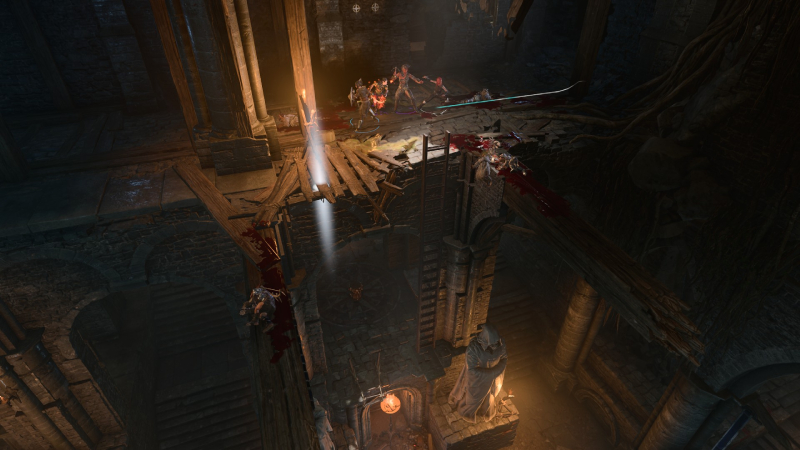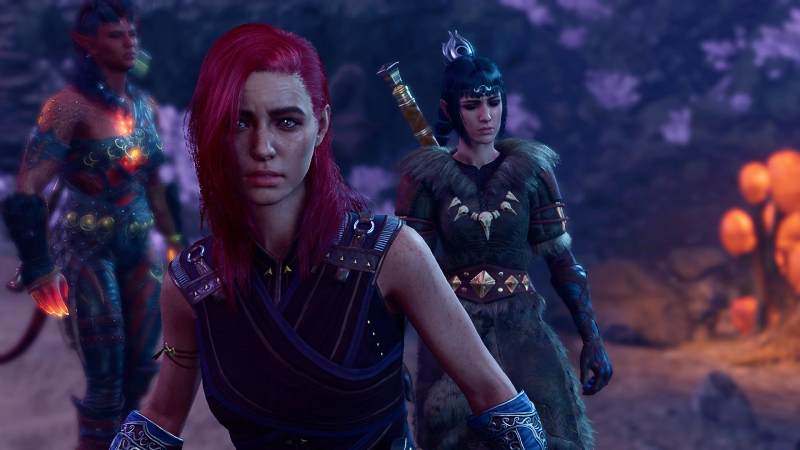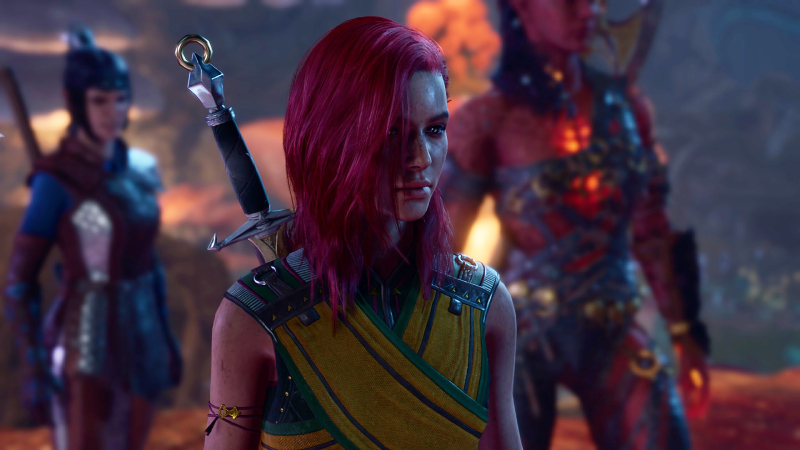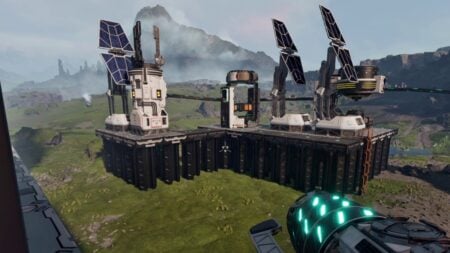Skip To...
It’s been a long journey for fans of Baldur’s Gate 3. Since the game launched in Early Access in 2020, we’ve all been waiting for the day to grab our companions and properly journey to the Forgotten Realms. Finally, the game has finally opened up for everyone, and it’s done so magnificently. While I’ll talk about some of the story elements, gameplay, and performance of Baldur’s Gate 3, this review focuses on the first chapter of the game, which many might have played during Early Access. All of this is to avoid spoilers and let you tailor your own adventure. Without further ado, let’s dive into what this new RPG has to offer.
Baldur’s Gate 3 Review: D&D For All
Baldur’s Gate 3 begins a few months after the Descent into Avernus adventure. The aforementioned tabletop campaign takes place in Baldur’s Gate and sees a group of adventurers traveling to the Avernus, the first layer of the Nine Hells, to rescue the city of Elturel and either kill, join, or redeem Zariel, a name you’ll hear a lot in Baldur’s Gate 3. While many thought the first games would connect to this entry, Descent into Avernus is practically the prologue. You’ll see that Wyll and Karlach are some characters with more connections to the tabletop adventure.
If you didn’t play the adventure or the first games, don’t worry, as the added context is helpful but certainly not necessary. Baldur’s Gate 3 begins with your character and other companions being abducted by Mind Flayers. These grizzly, nefarious creatures infect you with tadpoles. No, not the squirmy amphibian kind, but a special type of power that imbues our protagonist with new skills and talents. Anyway, with the help of Lae’zel and Shadowheart, you barely escape the Nautiloid after it crashes. From there, you’re thrown into a somewhat open world to find the abovementioned characters and new ones who also carry this strange tadpole power, just like you.
In particular, the story shines thanks to its colorful cast of characters, and as a result of your interactions with them. These branching conversations have a genuine bearing on the outcome of the plot. For example, you’ll encounter a Grove full of Druids that houses refugees from Elturel, the abovementioned city. In the Grove, you can help the refugees overthrow the Druids, start a civil war amongst them, or do other things I won’t spoil. All the choices you make will have repercussions for your party members. Back at your camp, which serves as a location to heal and rest, some party members might tell you what they think about your choices. Making good decisions builds rapport; making poor ones might see some characters leave you for good. Every choice matters. It is important to be mindful of your party members as everyone has their own story, and you might miss parts of them if you make them leave.
An Improvement Upon Divinity Original Sin 2
If you’ve played Larian Studios’ Divinity Original Sin 2, you might feel at home with the gameplay of Baldur’s Gate 3. Similarly, it takes the rules from the fifth edition of Dungeons and Dragons and puts them into a videogame format. Combat is a blend of turn-based tactical design and RPG elements. It features most of the spells you can find in the fifth edition books of DnD and makes them work flawlessly in the game.
Outside combat, a system will have you roll a die for certain ability checks. For example, let’s say you create a Rogue and give them a high skill in Deception. When speaking with, say, a Goblin and wanting to convince them to let you through their camp, you need to roll a die and pass a difficulty check. Depending on your stats, you’ll get bonuses for these checks. If you’re proficient with some skills, these bonuses will go higher; however, if you have low stats, your rolls will get a penalty.
It’s a clever feature as it really feels as though it raises the stakes during tense encounters. While you can save and load to try repeatedly, you’ll notice some choices are better when they are permanent, and you shouldn’t change them. Besides that, the game offers an enormous amount of replayability, which you’ll be able to see after finishing your first campaign.
Almost Flawless Performance
Baldur’s Gate 3 changed its system requirements in the build-up to launch, which understandably worried players’ potential performance woes. In my experience, though, there’s nothing to worry about. Played with an AMD Ryzen 5 5600 X, an NVIDIA GeForce RTX 3060 with 12 GB of VRAM and 16 GB of RAM 1080 locked at 60fps at Ultra Settings, performance was smooth. Larian did a great job optimizing the game for its launch, with almost no frame dips. The colors, the graphics, the models, everything looks sharp and way better than in early access. However, you might have to turn DLSS or DLAA, depending on your system, for better visual quality. Sadly, I noticed a few visual glitches, but only when playing co-op. In certain areas, a big black square would appear on the screen and stay there for a few seconds. This didn’t happen in single-player, though.
A Must-Play RPG
Even after having only played the first few chapters of the game so far, I’m confident in recommending Baldur’s Gate 3 as a must-play for RPG fans. The gameplay loop feels satisfying; the performance is superb, and there’s so much content to dive into. Even if you and your friends pick the same class, you won’t have the same experience. So far, I’m immensely pleased with what I’ve played so far, and it’s clear that Larian has once again raised the bar for the RPG genre. The characters, the gameplay, the music — everything works perfectly, and we can’t wait to see what’s coming in the later chapters of the game. If it holds up, we might have a new legendary RPG on our hands.
Baldur’s Gate 3 is available now on PC (Reviewed), PS5, and
Review copy provided by Publisher.
Baldur's Gate 3 (PC Reviewed)
Baldur's Gate 3 might as well be the game of the decade due to how it reinvents the wheel and gives player-agency to every single action in its long adventure.
Pros
- Easy-to-learn D&D systems.
- One of the best player-driven adventures of the decade.
- Memorable companions.
Cons
- Several optimization issues.
- Minor gameplay bugs.


